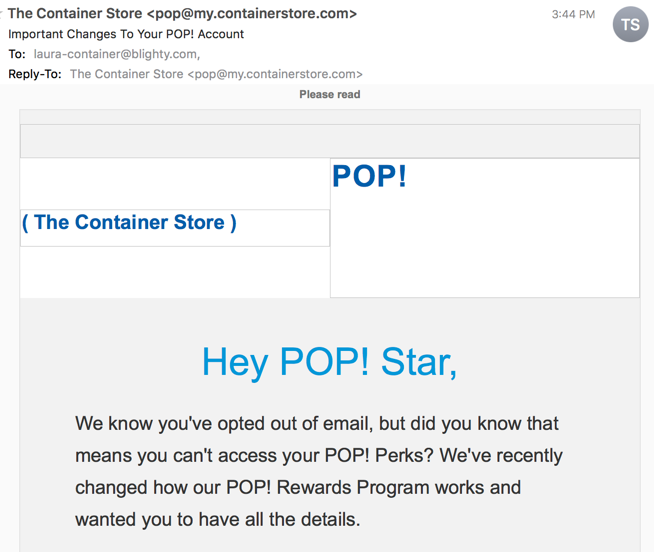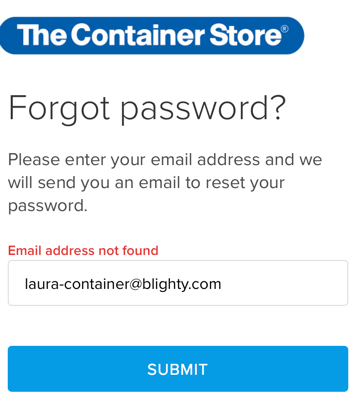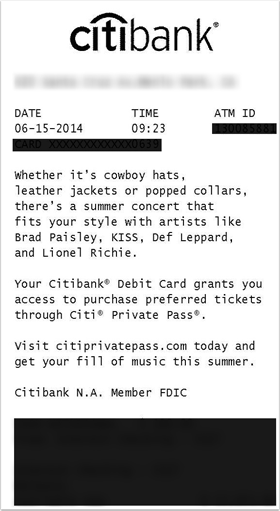Transactional
Opting out of “service” messages
- laura
- Oct 16, 2019
A frequent question in a number of deliverability spaces is how to tell if a message is transactional or marketing. In most cases the decision is related to whether or not to respect an unsubscribe request. All too often companies decide that their messages are too important to allow someone to opt-out of. The problem is, in some cases, there is no longer a customer relationship to send notices about.
Read MoreTransactional mail can be spam
- laura
- Oct 29, 2018
Marketers have a thing about transactional mail. In the US, transactional mail is exempt from many of the CAN SPAM regulations. If they label a mail transactional, then they can send it even when the recipient has opted-out! The smart marketer looks for opportunities to send transactional mail so they can bother spam get their brand in front of people who’ve opted out.
Schroedinger’s email
- laura
- Oct 3, 2018
The riskiest email to send is that very first email. It’s a blank slate. Even if you’re sending confirmation messages, you don’t really know anything about how this email is going to affect your reputation.
Read MoreUnsubscribe means unsubscribe
- laura
- Jul 19, 2018
But, unfortunately, some senders don’t actually think unsubscribe means stop sending mail.
Today, for instance, the nice folks at The Container Store sent me an email with an “important update to my POP! account”
Yes, that’s an address I gave them. But I don’t have any record of setting up an account. I was on their mailing list for all of 4 emails back in November 2016 before unsubscribing. But, they’ve decided they can email me despite my unsubscribe request.
They’ve cloaked this as an “Important Account Update” about some account I don’t have. In fact, when I go to their website and try and see what this oh so important account is about they tell me:
I understand legitimate account notifications might be an acceptable excuse to send mail even after the recipient opted out. This, however, was done extremely poorly. There is no record of the account that they are sending me information about. Neither the company nor I have any record of this account of mine.
At a minimum the emails should have only be sent to the folks that actually had an account. But, they weren’t.
I also have some issues with a company requiring recipients to accept email in order to continue using reward points. As a recipient, if I wanted what they were offering I might go ahead and continue receiving emails. But, I might not. It would all depend on how aggressive their email program is and how good the rewards are. As a deliverability consultant, this strikes me as a great way to create a mailing list full of unengaged users. Unengaged users lead to spam foldering and eventual failure of an email marketing program.
Whatever some executives think, and having been in this industry for a decade and I half I’m sure this is coming from the top down, this is not a good way to build an email program. You really can’t force folks to accept your email. ISPs are too protective of their users to make that a viable strategy.
Ask Laura: What about Transactional Opt-Outs?
- laura
- May 20, 2016

Dear Laura,
We are having a bit of an internal struggle on our end as we launch our new quarterly account summaries. What are your views on including an unsubscribe link in these emails?
My personal opinion is that we should. Although the summaries can be classified as “transactional”, they are not tied to a specific recent transaction a customer made and can be viewed as a general reminder to shop again. As I gathered data to present my case, I reviewed several different account summaries and I found it split close to 50/50. Do you have any data or thoughts to support one way or another?
Thanks,
Summary Judgement
Mandrill changes
- laura
- Mar 1, 2016
Last week Mandrill announced that they were discontinuing their free services and all customers would be required to have a corresponding paid Mailchimp account.
Read MoreJanuary 2016: The Month in Email
- laura
- Feb 4, 2016
 Happy 2016! We started off the year with a few different “predictions” posts. As always, I don’t expect to be right about everything, but it’s a useful exercise for us to look forward and think about where things are headed.
Happy 2016! We started off the year with a few different “predictions” posts. As always, I don’t expect to be right about everything, but it’s a useful exercise for us to look forward and think about where things are headed.
I joined nine other email experts for a Sparkpost webinar on 2016 predictions, which was a lot of fun (see my wrap up post here), and then I wrote a long post about security and authentication, which I think will be THE major topic in email this year both in policy and in practice (see my post about an exploit involving Trend Micro and another about hijacked Verizon addresses). Expect to hear more about this 2016 continues.
My other exciting January project was the launch of my “Ask Laura” column, which I hope will prove a great resource for people with questions about email. Please let me know if you have any questions you’d like to see me answer for your company or your clients — I’ll obscure any identifying information and generalize the answers to be most widely applicable for our readers.
In other industry news, it’s worth noting that Germany has ruled it illegal to harvest users’ address books (as Facebook and other services do). Why does that make sense? Because we’re seeing more and more phishing and scams that rely on social engineering.
In best practices, I wrote about triggered and transactional emails, how they differ, and what to consider when implementing them as part of your email program. Steve describes an easy-to-implement best practice that marketers often ignore: craft your mails so the most important information is shown as text.
I re-published an older post about SMTP rules that has a configuration checklist you might find useful as you troubleshoot any issues. And a newer issue you might be seeing is port25 blocking, which is important if you are hosting your own email senders or using SMTP to send to your ESP.
Finally, I put together some thoughts about reporting abuse. We work closely with high-volume abuse desks who use our Abacus software, and we know that it’s often not worth the time for an individual to report an incident – but I still think it’s worthwhile to have the infrastructure in place, and I wrote about why that is.
Triggered and transactional emails
- laura
- Jan 8, 2016
 Earlier this week I was talking on IRC with some colleagues. There was some kvetching about senders that think transactional emails are the same as triggered emails. This led to discussion about whether transactional and triggered emails are the same. I don’t think they are, but it took a while for me to come up with why I don’t think they’re the same. It took even longer to come up with definitions I liked.
Earlier this week I was talking on IRC with some colleagues. There was some kvetching about senders that think transactional emails are the same as triggered emails. This led to discussion about whether transactional and triggered emails are the same. I don’t think they are, but it took a while for me to come up with why I don’t think they’re the same. It took even longer to come up with definitions I liked.
Transactional Emails: Emails sent in response to direct request by the recipient. Transactional emails are usually one-off emails. Transactional emails probably don’t need an unsubscribe link, although it may be a good idea to include one just to make people feel comfortable receiving them. Examples: password reset emails, receipts, tickets.
Triggered Emails: Emails sent in response to an action by a recipient. Triggered emails can be one-off, but can also be series of emails. Triggered emails should have an unsubscribe link, so people can stop the emails if needed. Examples: cart abandonment emails, after purchase surveys, followups to software installation.
The key difference is that in a transactional email, the recipient has asked for that particular email. In a triggered email, the recipient may very well want and respond to the email, but they didn’t ask for it.
There are, as always, some grey areas here. Is a welcome message transactional or triggered? Probably transactional, but they should always have an unsubscribe link.
What about software installation followups? We’ve been looking at some alternatives to our current time tracking software which involved me setting up accounts at multiple different SaaS providers. A couple of them had triggered welcome series. These emails let me know things I could do with the software, things I still needed to set up, and led me through the process of trying out their system.
This was mostly good, but not completely. One of the series didn’t have an opt-out link, though. That was somewhat annoying because I’d already decided the tracker didn’t do what we needed. I couldn’t make the mail stop. I think if there is one thing I’d say about mail is that senders should never force someone to receive their mail.
It’s tempting for senders to define all triggered emails as transactional. Since it’s a user action that caused the mail to be sent, it must be a transactional email. But a lot of triggered emails are triggered by actions the user doesn’t know will trigger an email. Cart abandonment emails are a good example of this, not every retailer has them and so users aren’t yet expecting to get an email if they drop stuff in their carts and then leave the site.
Overall, both transactional and triggered emails have their place in a healthy email program. But they shouldn’t be confused for one another and should be treated as separate mail streams.
September 2015: The month in email
- laura
- Oct 2, 2015
 September’s big adventure was our trip to Stockholm, where I gave the keynote address at the APSIS Conference (Look for a wrapup post with beautiful photos of palaces soon!) and had lots of interesting conversations about all things email-related.
September’s big adventure was our trip to Stockholm, where I gave the keynote address at the APSIS Conference (Look for a wrapup post with beautiful photos of palaces soon!) and had lots of interesting conversations about all things email-related.
Now that we’re back, we’re working with clients as they prepare for the holiday mailing season. We wrote a post on why it’s so important to make sure you’ve optimized your deliverability strategy and resolved any open issues well in advance of your sends. Steve covered some similar territory in his post “Outrunning the Bear”. If you haven’t started planning, start now. If you need some help, give us a call.
In that post, we talked a bit about the increased volumes of both marketing and transactional email during the holiday season, and I did a followup post this week about how transactional email is defined — or not — both by practice and by law. I also wrote a bit about reputation and once again emphasized that sending mail people actually want is really the only strategy that can work in the long term.
While we were gone, I got a lot of spam, including a depressing amount of what I call “legitimate spam” — not just porn and pharmaceuticals, but legitimate companies with appalling address acquisition and sending strategies. I also wrote about spamtraps again (bookmark this post if you need more information on spamtraps, as I linked to several previous discussions we’ve had on the subject) and how we need to start viewing them as symptoms of larger list problems, not something that, once eradicated, means a list is healthy. I also posted about Jan Schaumann’s survey on internet operations, and how this relates to the larger discussions we’ve had on the power of systems administrators to manage mail (see Meri’s excellent post here<).
I wrote about privacy and tracking online and how it’s shifted over the past two decades. With marketers collecting and tracking more and more data, including personally-identifiable information (PII), the risks of organizational doxxing are significant. Moreso than ever before, marketers need to be aware of security issues. On the topic of security and cybercrime, Steve posted about two factor authentication, and how companies might consider providing incentives for customers to adopt this model.
Transactional mail
- laura
- Oct 1, 2015
 There are a lot of myths in the email space. Things that someone, somewhere said and another person repeated and then another person repeated and all of a sudden it is TRUTH. One of those things is the idea that there is a law defining what can be in a transactional email. Supposedly this law says that 80% of the message must be transactional content while 20% of the mail can be promotional content.
There are a lot of myths in the email space. Things that someone, somewhere said and another person repeated and then another person repeated and all of a sudden it is TRUTH. One of those things is the idea that there is a law defining what can be in a transactional email. Supposedly this law says that 80% of the message must be transactional content while 20% of the mail can be promotional content.
This isn’t really a law. I was even going to say it’s kinda a good idea, but then I stared thinking about it. It doesn’t even really make sense. 80% of what? Size? Space? Bytes? Layout? Do headers count in the 80% or just what’s visible? Does the HTML code count? What makes for “new” content?
Adding promotional content to receipts is great for conversions. It’s a great way to get someone to opt-in to mail. It’s a great way to upsell. It’s great for engagement; that makes it good for deliverability. Senders should include some level of promotional mail in receipts whenever possible.
There are some guidelines I suggest when looking at transactional mail.
Transactional advertising
- laura
- Jun 17, 2014
 One of the things our bank does that I really like is send ATM receipts directly to the email address associated with the ATM card. No more random pieces of paper I have to track down, it’s all there in my mailbox. This week I noticed that the bank is leveraging the transactional mail to tell me about new services they provide.
One of the things our bank does that I really like is send ATM receipts directly to the email address associated with the ATM card. No more random pieces of paper I have to track down, it’s all there in my mailbox. This week I noticed that the bank is leveraging the transactional mail to tell me about new services they provide.
I think this is awesome. I get my receipt and I get to learn about bank services I didn’t know about previously.
I don’t remember if the bank made me confirm my address when I signed up for online banking, it was a long time ago. But if they did, then they have a dedicated, confirmed advertising channel right to my mailbox. Good for them, convenient for me.
A win-win.
Don't leave that money sitting there
- laura
- Apr 11, 2013
The idea of confirming permission to send mail to an email address gets a lot of bad press among many marketers. It seems that every few weeks some new person decides that they’re going to write an article or a whitepaper or a blog and destroy the idea behind confirming an email address. And, of course, that triggers a bunch of people to publish rebuttal articles and blog posts.
I’m probably the first to admit that confirmed opt-in isn’t the solution to all your delivery problems. There are situations where it’s a good idea, there are times when it’s not. There are situations where you absolutely need that extra step involved and there are times when that extra step is just superfluous.
But whether a sender uses confirmed opt in or not they must do something to confirm that the email address actually belongs to their customer. It’s so easy to have data errors in email addresses that there needs to be some sort of error correction process involved.
Senders that don’t do this are leaving money on the table. They’re not taking that extra step to make sure the data they were given is correct. They don’t make any effort to draw a direct line between the email address entered into their web form or given to them at the register or used for a receipt, and their actual customer.
It does happen, it happens enough to make the non-tech press. Consumerist has multiple articles a month on some email address holder that can’t get a giant company to stop mailing them information about someone else’s account.
Just this week, the New Yorker published an article about a long abandoned gmail address that received over 4000 “legitimate” commercial and transactional emails.
Spamhaus Speaks
- laura
- Mar 5, 2013
There’s been a lot of discussion about Spamhaus, spam traps, and blocking. Today, Spamhaus rep Denny Watson posted on the Spamhaus blog about some of the recent large retailer listings. He provides us with some very useful information about how Spamhaus works, and gives 3 case studies of recent listings specifically for transactional messages to traps.
The whole thing is well worth a read, and I strongly encourage you to check out the whole thing.
There are a couple things mentioned in the blog that I think deserve some special attention, though.
Not all spam traps actually accept mail. In fact, in all of the 3 case studies, mail was rejected during the SMTP transaction. This did not stop the senders from continuing to attempt to mail to that address, though. I’ve heard over and over again from senders that the “problem” is that spamtrap addresses actually accept mail. If they would just bounce the messages then there would be no problem. This is clearly untrue when we actually look at the data. All of the companies mentioned are large brick and mortar retailers in the Fortune 200. These are not small or dumb outfits. Still, they have massive problems in their mail programs that mean they continue to send to addresses that bounce and have always bounced.
Listings require multiple hits and ongoing evidence of problems. None of the retailers mentioned in the case studies had a single trap hit. No, they had ongoing and repeated trap hits even after mail was rejected. Another thing senders tell me is that it’s unfair that they’re listed because of “one mistake” or “one trap hit.” The reality is a little different, though. These retailers are listed because they have horrible data hygiene and continually mail to addresses that simply don’t exist. If these retailers were to do one-and-out or even three-and-out then they wouldn’t be listed on the SBL. Denny even says that in the blog post.
Confirming addresses for transactional mail
- laura
- Dec 11, 2012
A colleague was asking about confirming transactional mail today. It seems a couple of big retailers got SBLed today for sending receipts to spamtraps. I talked a few weeks ago about why it’s important to let people unsubscribe from transactional email, and many of those same things apply to confirming receipts.
Read MoreMarketing and storms
- laura
- Nov 6, 2012
Never let it be said that marketers can’t take advantage of anything. In this case, there was a lot of commercial email mentioning Hurricane Sandy sent over the last few days. The emails themselves mapped into a number of broad categories.
Informational: Emails from hotels, airlines and east coast businesses keeping customers updated about their current status. Emails from many banks also fell into this category. Generally these emails offered information about reservations, flight statuses and cancellations. In the case of banks, customers were also told about loosening of overdraft and other policies.
Sales: Some retailers used the storm as an excuse for a storm. American Apparel sent out an email advertising a 36 hour sale for residents in states on the hurricane path. This prompted some recipients to complain about the tastelessness of the advertising.
Relief efforts: A number of companies sent out emails encouraging subscribers to donate to relief efforts. In many cases these companies are located in or have employees directly affected by the storm. Some of these companies offered discounts or bonuses to people who donated to relief efforts.
Spam: Finally, I would be remiss in not pointing out that spammers and scammers come out in force after most natural disasters. Spammers took full advantage of the storm, too and were sending out lots of mail mentioning the storm. Mailchimp dedicated a full blog post to looking at the amount of spam mentioning the storm and its impact on email delivery.
Return Path has an analysis of some of the Sandy related mailings and how they performed both between categories (although Return Path didn’t categorize them like I did) and within categories. It’s well worth a read to see how different approaches worked.
Email is a great way to communicate with people. The breadth of emails going out about or referencing the storm are a testament to that.
Letting people stop transactional mail
- laura
- Jul 24, 2012
The question of putting unsub links on transactional messages came up on multiple lists recently. As with any question that has to do with email and controlling it, there were a lot of different opinions.
A number of people believed that transactional mail should never, ever have an unsubscribe. Their argument was that transactional mail is too valuable to allow recipients to unsubscribe from it.
Other people argued that the recipient should always be able to stop mail and that an unsub link was important, even in transactional mail.
A third group pointed out that under CASL transactional mail to Canadian residents may have to have an unsub link, even if the sender doesn’t want to add one in.
As with most questions, I don’t think there is necessarily a single answer for every mailer or sender.
There are absolutely cases where transactional messages should have an unsubscribe. Twitter notifications and Facebook notifications are just some of the examples of mail a lot of people just want to stop.
But should companies allow recipients to unsubscribe from receipts? Some people feel very, very strongly that recipients should never be allowed to unsubscribe from receipts.
The problem with that stance is it ignores the fact that people don’t always correctly type their email addresses and end up giving the address of another person as part of a purchase. Al found a report at the Consumerist where someone is getting flooded with receipts for Nook books she’s never purchased.
This isn’t the first time this has happened, not by a long shot. In fact, in the past year I negotiated a Spamhaus delisting for a very large company that wasn’t confirming email addresses of their customers. This company sells a service that sends email alerts triggered when certain actions happen. Because they were not confirming their customer’s email addresses, they ended up sending alerts to spamtraps. The alerts triggered a SBL listing.
I don’t think that the Nook owner or the alert purchaser are actually malicious or that they purposely gave the wrong email address to their vendors. But it happens, and it happens not infrequently.
What do I recommend?
Transactional mail that is only ever a single event and where that address is not associated with an account don’t need to have an unsubscribe link. If it’s a one-time email, then it’s OK to not have an opt-out link. It’s OK to have an opt-out link, but not necessary.
Transactional mail that’s associated with some sort of account should have a process in place to make sure that mail is going to the right person and if it’s not, that the wrong person can make the mis-directed mail stop. There are multiple ways to do this. One is to confirm the email address associated with the account during the account creation process. Or you can allow anyone receiving the mail to click on a link and opt-out of receiving mail.
Whatever it is, it needs to be effective and protect everyone involved. Requiring the victim recipient to hand over a bunch of personal information, like Virgin Mobile does, helps no one. Continuing to send purchase receipts to an unrelated third party is poor business practice, particularly when you’ve been informed that this is the wrong person.
Thoughts on transactional mail
- laura
- Jul 7, 2009
I mentioned a few weeks ago about a conversation I’d had at MAAWG about transactional email and opened up the conversation to readers here. Mike proposed a definition.
Read MoreTransactional email
- laura
- Jun 11, 2009
I was talking with some people at the conference yesterday and we started discussing what makes an email transactional. I am reluctant to say the best definition we came up with was “I know it when I see it” but it was close. The interesting thing was that most of the participants agreed that we all used the term the same.
I thought I’d ask readers here: How do you define transactional email? I’m interested in this both from the perspective of a sender and from the perspective of a receiver.
Transactional emails
- laura
- Oct 8, 2008
Tamara has an excellent collection of musts related to transactional email. I would add a few more, specific to traveling (hotel and plane reservations) that occurred to me recently as I was bombing through airports trying to read hotel and airline confirmations on my iPhone.
Read More